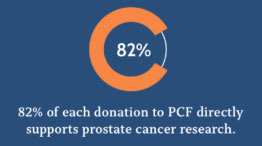Overview:
- Prostate cancer is the most common non-skin cancer in America.
- In the United States, 1 in 8 men will be diagnosed with prostate cancer in his lifetime.
Learn more about the symptoms to watch out for, screening recommendations, causes, and survival rates.
Symptoms:
Unfortunately, there usually aren’t any early warning signs for prostate cancer. The growing tumor does not push against anything to cause pain, so for many years the disease may be silent. That’s why screening for prostate cancer is such an important topic for all men and their families.
When your doctor suspects you may have prostate cancer, what comes next is a careful series of tests and examinations that will confirm the diagnosis and assess the extent of the disease. Most prostate cancer cases are highly treatable, but first, your care team needs to know exactly what you’re dealing with.
Learn more and watch the video overview
Causes:
If you or a loved one has recently been diagnosed with prostate cancer, your mind might be racing, trying to figure out what happened. What went wrong? What could we have done differently so that this wouldn’t happen? The answer is simple, but unsatisfying: doctors and researchers really don’t know—yet.
There are three well-established risk factors for prostate cancer diagnosis: Black race, family history of prostate cancer, and increasing age. (Learn more about risk factors for prostate cancer.) Additional factors, like smoking and obesity, are linked to aggressive prostate cancer and worse outcomes once a man is diagnosed.
One of the biggest apparent underlying factors is one we have little control over: our genes. Learn More and watch the video overview.
Risk Factors:
As indicated by the rates of diagnosis, age is the biggest—but not the only—risk factor for prostate cancer. Other important factors include:
- Family history
- Genetic factors
- Race
Genes for disease can run in families. Men who have a relative with prostate cancer may be twice as likely to develop the disease, while those with 2 or more relatives are nearly 4 times as likely to be diagnosed. The risk is even higher if the affected family members were diagnosed before age 65.
As we begin to unlock the genetic underpinnings of cancer, we realize more and more that men may also be at increased risk of prostate cancer if they have a strong family history of other cancers, such as breast cancer, ovarian cancer, colon cancer, or pancreatic cancer.
Because family members share many genes, there may be multiple genetic factors that contribute to the overall risk of prostate cancer in a family. However, there are also some individual gene changes (mutations) that we now know increase the risk of prostate cancer, and men with these mutations may need to be screened differently or consider changes in treatment.
Scientists don’t yet know why, but men of African descent are about 75% more likely to develop prostate cancer compared with white men, and about two times more likely to die from the disease. Learn More.
Myths and Non-Risks:
Sexual Activity: High levels of sexual activity or frequent ejaculation have been rumored to increase prostate cancer risk. This is untrue. In fact, studies show that men who report more frequent ejaculations may have a lower risk of developing prostate cancer.
Vasectomy: Having a vasectomy was originally thought to increase a man’s risk, but this has since been disproven.
Medications: Several recent studies have shown a link between aspirin intake and a reduced risk of prostate cancer by 10-15%. This may result from different screening practices, through a reduction of inflammation, or other unknown factors.
Statin use: The class of drugs called statins – known to lower cholesterol – has also recently been linked to a reduced risk of aggressive prostate cancer in some studies.
Alcohol: There is no known direct link between alcohol and prostate cancer risk.
Vitamin E: Recent studies have not shown a benefit in consumption of vitamin E or selenium (in the formulations studied) in the prevention of prostate cancer.
(Some of the information on this page is adapted from Dr. Patrick Walsh’s Guide to Surviving Prostate Cancer.)
Treatment Side Effects:
Because the prostate is close to several vital structures, prostate cancer and its treatments can disrupt normal urinary, bowel, and sexual functioning. This section discusses side effects that might be experienced as well as advice on managing those side effects.
Early management of side effects has been shown to help patients live longer, better lives.
It is very important that you communicate with your doctors about the side effects that you are experiencing as you undergo treatment. Ongoing and proactive communication will enable your doctor to manage your side effects as early as possible to prevent worsening or development of downstream complications.
Prevention and Living Well:
The ultimate goal is to prevent men from developing prostate cancer. Although significant progress has been made and genetic and environmental risk factors for prostate cancer have been identified, the evidence is not strong enough for conclusive recommendations on prostate cancer prevention overall.
However, diet and lifestyle modifications have been shown to reduce the risk of prostate cancer progression, and can help men with prostate cancer live longer and better lives. Learn More
- Adopt an “anti-inflammatory diet,” low in red meat, sugar, processed foods, and dairy products, and high in foods that fight inflammation.
- Exercise regularly, within the bounds of safety for your personal physical fitness level. Even moderate exercise has been shown to reduce a man’s chance of developing lethal forms of prostate cancer.
- Swap red meat for plant-based protein and fish. Saturated fat in red meat is a cause of inflammation, which is associated with cancer and other chronic diseases. Avoid trans fatty acids (e.g., margarine, packaged baked goods).
- Watch your calcium intake. Very high amounts of calcium may increase risk of aggressive prostate cancer. Try to get most of your calcium from plant-based food sources (e.g., almonds, tofu, leafy greens) rather than supplements, unless your doctor has advised otherwise.
- Incorporate a variety of brightly-colored vegetables into your meals. Vegetables contain naturally-occurring antioxidants that protect your cells from damage by “mopping up” harmful free radicals.
- Avoid smoking for many reasons. Drink alcohol in moderation, if at all.
- Seek medical treatment for high blood pressure, diabetes, high cholesterol, and depression. Treating these conditions may save your life and will improve your survivorship with prostate cancer.
- Avoid over-the-counter supplements, unless recommended by your doctor. While a multivitamin is not likely to be harmful, you probably don’t need it if you follow a healthy diet with lots of vegetables, whole grains, fish, and healthy oils.
- Relax and enjoy life. Reducing stress in the workplace and home will improve your survivorship and lead to a longer, happier life.
- For men 45 or older (40 or older for Black men and men with a family history of prostate cancer), discuss the risks and benefits of screening with a PSA test with your doctor. Early detection is key.
Prostate Cancer Frequently Asked Questions
- Prostate cancer is the most common non-skin cancer in men in the U.S., and the 4th most common tumor diagnosed worldwide.
- In the United States, 1 in 8 men will be diagnosed with prostate cancer in his lifetime.
- For Black men, 1 in 6 will develop prostate cancer and are more than twice as likely to die from the disease.
- In 2024, more than 299,000 U.S. men will be diagnosed with prostate cancer, and more than more than 35,000 will die from the disease. That’s one new case diagnosed every 2 minutes and another death from prostate cancer every 15 minutes.
- A man is more likely to develop prostate cancer than he is to develop colon, kidney, melanoma, and stomach cancers combined.
- It is estimated that more than 3 million U.S. men are living with prostate cancer.
- Prostate cancer is the most common non-skin cancer in men in the U.S., and the 4th most common tumor diagnosed worldwide.
- A man is more likely to develop prostate cancer than he is to develop colon, kidney, melanoma, and stomach cancers combined.
- The chance of being diagnosed with prostate cancer increases rapidly after age 50. About 6 in 10 of all prostate cancers are diagnosed in men over the age of 65.
- For Black men, 1 in 6 will develop prostate cancer and are more than twice as likely to die from the disease. You can read more about prostate cancer in Black men here.
- Prostate cancer is among the most heritable of the major human cancers; It is estimated that more than half (57%) of prostate cancer risk is due to genetic factors.










